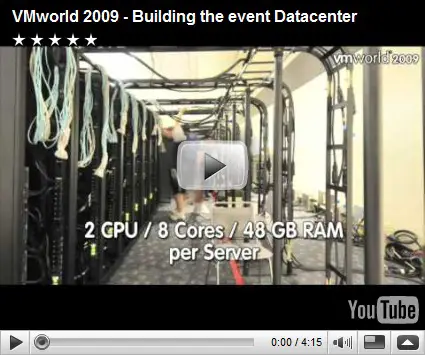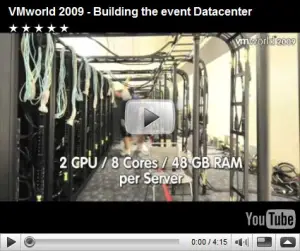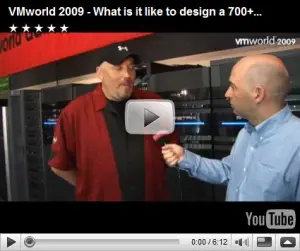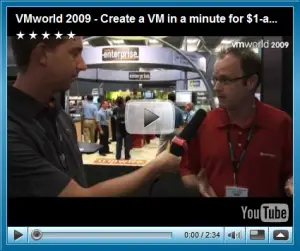Even More blogs on VMworld 2009!
I take no credit for any of this content, it go’s to the author, and mean to only put the content here without having to weed through the varies blogs, I have both the blog link, and article title here, with a link to the article. Thanks to everyone for putting these together for everyone to read!
——
http://www.vmguru.nl/wordpress : Building and maintaining the VMworld 2009 Datacenter
“It is becoming a sequel, the datacenter VMware has build for this weeks VMworld 2009 at the Moscone Center in San Francisco.
In addition to our two previous articles (art1, art2), today we found two very nice videos loaded with tons of techno porno!
The first video shows the VMware team building the complete datacenter on-site at the Moscone Center. During the video footage the awesome numbers representing this huge infrastructure run by.
In short? 28 racks containing 776 ESX servers which provide the infrastructure with 37TB of memory, 6.208 CPU cores and 348TB storage which uses 528KW electricity and is servicing 37.248 virtual machines. You will probably never find such an infrastructure anywhere in the world, at least I know I won’t.
In the second video Richard Garsthagen is interviewing Dan, who is responsible for the datacenter at the Moscone Center, in which he gives inside information on how this huge datacenter is designed, build, connected and what hardware is used. Some interesting figures 85% of the used hardware is new to market, they only used 3 miles of cable to connect all 776 ESX servers, storage, switches, etc and the total cost of all hardware used to build this datacenter is estimated at $35M!
Awesome figures, a very very impressive datacenter and a must see for all technology freaks out there.
Respect for VMware for putting together such a datacenter just for a one week event!”
—-
http://www.vmwarewolf.com : vCloud Express attracting buzz
“
Out of the many product enhancements and releases being marketed at VMworld this week comes one that is really causing a stir and buzz in the user community and that is vCloud Express.
vCloud Express is a service whereby you pay a 3rd party to host your virtual servers on the Internet. Five providers are already ready to host your cloud at very cheap rates (I heard a dollar a day). You don’t get locked in either. If you choose to later host your own internal cloud you can do that.
Look out Amazon EC2
While this service can and will directly compete with Amazon, VMware is going to be hosting the clouds themselves. They provide the API, and providers provide the infrastructure.
As cloud computing gains ground on a commercial basis, VMware seems poised to once again to have the upper hand.”
—
http://netapptips.com : VMworld 2009: Preview of the Day (Wednesday)
“
VMworld2009 continues to roll-on with exciting things being announced every day.
Quick recap of yesterday and then a preview of all things NetApp that
you’ll be able to find in and around the show.Day 2 (Tuesday)
- NetApp extended our 50% Virtualized Storage Guarantee by creating the $1M Challenge. @Vaughn_Stewart includes some commentary around the new program
- We posted the first batch of our demos that are running in the NetApp booth (#2102): VMware View Performance with NetApp Intelligent Caching, NetApp DataMotion, NetApp + VMware SRM updates, NetApp SnapMirror Plugin for vCenter, and SANscreen Plugin for vCenter.
Day 3 (Wednesday)
- Come visit the NetApp booth (#2102) and check out the mini-theatre
presentations every 20 minutes. DataMotion, Large Scale VDI
Deployments, SMVI 2.0, RCU 2.1, VSC, Secure Multi-Tenant Cloud
Architecture will all be covered by our expert speakers.- NetApp customer @ric_vmwaretips will be participating in the NetApp Technical Reference Roundtable from 12:30-1:30pm in Moscone 270.
- NetApp’s Larry Touchette and Jeremy Merrill will be presenting "Best Practices for Recovery with SRM and NFS in vSphere" (BC3210) at 1:30pm in North Hall 110
- NetApp founder Dave Hitz and VMware CTO Steve Herrod will be presenting a SuperSession (SS4880) on "Clear up the cloud: Key infrastructure requirements and real-world implementations" at 2:30pm along with our joint customer T-Systems.
- @Vaughn_Stewart
and @Mike_Laverick (RTFM) will present "How Storage Enhances Business Continuance: From Backup to Fault Tolerance" (BC3189) at 4pm in Moscone North, Hall E, Room 134.- NetApp customer Marvell will be presenting their "Migration of Exchange 2007 to vSphere" at 4pm in session EA2631, Esplanade 307.
- NetApp customer USPTO will be presenting their "Journey to Teleworkers" (using VDI) at 4pm in session DV2861, Esplanade 307. “
—-
http://blog.scottlowe.org : VMworld 2009 Day 2 Keynote
“
The day 2 keynote starts with another entertaining video.
After the video concludes, Steve Herrod, VMware’s CTO, takes the stage. He echoes that virtualization is a “tectonic shift” in the IT industry. Herrod again shows the three pillars—VMware vSphere, VMware View, and VMware vCenter. Herrod’s initial focus is on VMware View, due to the increased emphasis on desktop virtualization and the focus VMware is providing in that arena.
VMware vSphere provides the foundation for desktop virtualization and is the best platform for desktop virtualization due to commonality, security, availability, and efficiency. VMware’s advances in this area are coupled with advances by Intel (Xeon 5500) and storage (high-speed block caching, for example). VMware View builds on this foundation to enable faster and more efficient image provisioning, image updating, and policy enforcement. One piece that helps with this is the effort that VMware has placed into decoupling the OS, applications, and user profiles.
VMware is announcing this morning that they will be OEM’ing RTO Virtual Profiles to assist in decoupling user profile/user personality data from the underlying OS image and the applications. Unfortunately, Herrod did not provide any additional detail on exactly how RTO’s product will be integrated (or if it will even be integrated).
User experience is another key point. To that end, VMware has been focusing on the user experience to enable the “productive desktop” across the WAN, the “PC-like desktop” across the LAN, and the “rich portable desktop” using VMware CVP (Client Virtualization Platform).
To help with user experience on the LAN and WAN, VMware has been working closely with Teradici on PC over IP (PCoIP). VMware’s implementation of PCoIP is software-only, but fully supports hardware acceleration. This enables the use of the same protocol from task workers to knowledge workers to designers. PCoIP will be included in the next version of VMware View and will be shipping later this year.
Employee-owned IT (EOIT) is another area that VMware is trying to enable. This can be accomplished in a couple of different ways. One way is using hosted virtualization with a product like VMware Workstation, VMware ACE, or VMware Fusion. VMware ACE has policy support (and I think that Workstation does as well), but Fusion does not have policy support, so it sounds like VMware is planning on extending policy support across all hosted virtualization platforms.
Of course, CVP is the primary focus for VMware, where they are leveraging their relationship with Intel and using the Intel vPro technology to perform desktop virtualization with a local hypervisor but managed centrally via VMware View. This leads into a demo of CVP. The demo shows Windows 7 running on a local Type 1 hypervisor, and then shows a session using a thin client on a local connection using PCoIP. The demo wraps up with a demonstration of using Wyse PocketCloud on an iPhone.
Regarding VMware’s mobile strategy, Herrod begins to discuss the various ways in which VMware is enabling the use of mobile devices. vCenter Mobile Administrator is one product that VMware is providing, plus the VMware View-approved iPhone clients like PocketCloud, and—of course—virtualizing the phones themselves. This leads into a discussion of VMware Mobile Virtualization Platform (MVP).
VMware MVP is about device freedom as well as application freedom. Visa takes the stage and, rightfully so, Herrod asks why Visa is on the stage for mobile virtualization. His focus is about enabling financial services on mobile platforms without compromising security. MVP helps cut complexity to enable that functionality. Herrod then introduces Srinivas Krishnamurthy to show an MVP demo.
The MVP demo primarily focuses on the Visa Mobile app, but Srinivas then exposes the relationship of this demo to MVP: the application he’s showing is a Google Android application running on a Windows Mobile phone. This enables users to use whatever application they want regardless of the platform.
Herrod now shifts the focus to VMware vSphere. (He promises not to demonstrate VMware Fault Tolerance again.) Once again Herrod brings up the idea of the software mainframe. VMotion is a key component, a key enabler, of the giant computer (aka the software mainframe aka the cloud). This is the sixth anniversary of VMotion, and VMotion now has maturity, breadth, and automated use. Herrod says VMware estimates a new VMotion migration occurs every 2 seconds. (Where does that calculation come from?)
VMotion was extended to Storage VMotion in late 2006, and with vSphere it was extended again to Network VMotion, and extended again with long distance VMotion via some additional partners and vendors. Herrod sees VMotion as a major part of VMware’s drive to greater efficiency (one of three marketing pillars around vSphere: efficiency, control, and choice). This is because VMotion is a foundational technology for VMware DRS. He uses the recent study about DRS and improved performance as an example. VMware DRS is being extended (no timeframe yet) to include I/O. This includes the ability to assign shares and IOPS values to individual VMs.
VMotion and VMware DRS are combined yet again to form a foundation for VMware DPM, which enables greater power efficiency.
Herrod next moves from efficiency to control, and what VMware is doing is this area. His first topic in this space is VMware AppSpeed, which helps organizations provide a level of control over application performance. Next Herrod moves into a discussion of vApp, which is a logical collection of one or more VMs described using OVF. This will help enable the “IT service” policy descriptor. This means embedding SLA definitions into the OVF standard and enabling vSphere to act upon those definitions appropriately.
The VMsafe APIs are another point of control and are now officially available with VMware vSphere (released back in May). Embedding security policies into the OVF description and integrating it with vApp is another method of extending control in a policy-based way.
Next Herrod moves into a demonstration of VMware ConfigControl. This is the first time ConfigControl has been demonstrated. The demo was a bit limited, but considering that it won’t be shipping until early next year that’s not too terribly surprising.
Herrod finally moves on to the third vSphere marketing tenet: choice. Choice includes choice of hardware and choice of where to run applications. Herrod also sees choice as including self-service IT, which leads to a discussion of Lab Manager. (It sounds to me like Lab Manager is a major central focus point for VMware as enabling self-service IT.)
The last focus point in Herrod’s keynote is cloud computing, i.e., VMware vCloud. (I suspect we’ll see more information on vCloud Express and the official announcements of the vCloud APIs.) Herrod calls out the use case of Site Recovery Manager to connect two internal data centers as a (limited) form of cloud connectivity that customers are using today.
Long-distance VMotion is another level of cloud connectivity that VMware and associated partners are trying to tackle. There are lots of challenges to be addressed here. Why is long-distance VMotion so important or interesting? It could be follow the sun computing, disaster avoidance, etc. In the partner realm, Cisco is one partner that is working on long-distance VMotion, but there are still network identity challenges. F5 is using BigIP to abstract network identity to help address some of the challenges around long-distance VMotion.
Moving on to the VMware vCloud APIs, Herrod talks about a few applications leveraging the API. He also reiterates that the vCloud API has been submitted to the DMTF for consideration as a multi-vendor standard. This will help foster choice.
At the beginning of the keynote, Herrod laid out three initiatives: View, vSphere, and vCloud. Now he adds a fourth one: vApps. This is more related to the SpringSource acquisition, not to the vApp functionality within vSphere (as far as I can tell). Herrod begins to explain how the SpringSource acquisition allows VMware to move “up the stack” from Infrastructure as a Service (IaaS) into Platform as a Service (PaaS) and provide more products to support Software as a Service (SaaS). Adding SpringSource to the VMware mix gives VMware coverage in 2/3 of the cloud definitions (IaaS and PaaS covered).
This move also allows VMware to optimize the IaaS and PaaS layers to provide even greater performance, mobility, and management for SaaS vendors, developers, and providers. Adrian Coyler, CTO of SpringSource, now takes the stage for a demonstration.
The demonstration shows a Java application being deployed to an external cloud using CloudFoundry, a company that SpringSource themselves acquired just in the last month or so. This demonstration was actually shown yesterday during Maritz’ vCloud event.
Herrod wrapped up the keynote with a summary of the key takeaways.”
—
http://vmetc.com : VMworld 2009 Wednesday Keynote
“
Keynote 2 Live Blog
5:14 am PST – I will begin the live blog when I’m set up in my seat in the Keynote Hall. More then. #vmwkn2 Tweetgrid is up.
7:49 am – in same seat as yesterday. Doors have been open to the hall for about 20 mins. Keynote filling up. Music is playing …
7:57 am – announcement made to silence cell phones. Here we go. Looking forward to Steve Herrod’s demos in this session.
8:01 – lights went down right at 8 am and Herrod is already on stage. No intro today!
Steve is going to build on yesterday’s talk about the journey to virtualization. he says he has 2 goals today – learn about the future and have fun doing it. He emphasizes that with the legal forward looking statements slide.
He begins with VDI and VMware View. He calls out vSphere as the right platform for desktop virtualization. He says Windows desktops were key focuses for making sure performance enhancements in vSphere. Commonality, Security, Availability, and Efficiency are key pillars of VMware’s desktop solution and are displayed the monitor now.
Steve is explaining that centralized image and policy management are keys in the View solution. How to share images, simplify patching, and backup desktops, data and user personalities are key concerns.
Side note : “tentacles must be the new buzz word at VMware. I’ve heard Maritz mention it repeatedly, and now Steve is using it to describe the dependencies to provide the integrated features that meet the focus points on VMware View.
Steve now wants to talk about PCoIP and the best user experience to all endpoints. VOIP, 3D graphics, offline usage, and hardware accelerators in clients are some of the highlights of virtual desktops leveraging the PCoIP protocol. Steve has announced it will be shipping this year, but he did not give a GA date.
Starting to talk about VDI client scenarios, Steve is now talking about hosted desktop solutions such as Fusion, workstation, and Ace. He calls this employee owned IT. The future is bare metal client hypervisors and what Steve calls “corporate owned IT” in the centralized data center.
The first demo is a VMware View demo. We see a CVP connected to a VMware VIew Windows 7 VM. The demo shows the 3D chess game, you tube videos, and the Windows 7 effects. This is all posisble because of the virtualized GPU using the CVP client’s hardware. Next the demo moves to show a remote connection to a View desktop via a View client on a Windows PC. Google Earth is demoed with full graphic functionality via the PCoIP protocol. Finally the Wyse pocket cloud is demoed on an iPhone. The remote connection is shown on the monitors and the iPhone gestures features are used to move around, shrink, and expand the desktop. That gets some spirited applause.
Steve then quickly talks about the VMware CMA available for the phone. This is the ability to manage vSphere and the VMs from a web interface on a mobile phone. Steve also reveals that they are working on a similiar phone admin tool for VMware View Manager too.
Keeping with the mobile phone theme, we’ve moved to a discussion and a demo on MVP – VMware’s effort to virtualize the OS on mobile devices to allow multiple platforms to run on a single device. The demo is a VISA app on a mobile device running MVP. The VISA app keeps track of your transactions and sends you offers. Then a locator function is shown for using Google Maps to find an ATM. We are told this VISA apps is actually an Android app and then shown that both Windows CE and Android are running simultaneously on the device and MVP enables seamless integration between the OSes (like Fusion and Workstation). Nice!
Steve begins to talk about efficiency in vSphere solutions.
Steve shifts to VMotion and how partners are developing products with VMotion built in? VMware has been talking about and offering VMotion for 6 years now, and in that honor “I Like to Move It” from the movie Madagascar is played over the loud speakers. The crowd got a laugh out of that, and Steve declares we won’t be able to VMotion VMs without thinking of that song from now on. He also shows a graphic with estimated marriages saved because of VMotion. The number is a modest 74 and counting …
Steve is now pitching the “ready to virtualize all applications” message and the giant computer example. This leads to a discussion about DRS. The message is that vSphere and DRS make possible a higher peak capacity for workloads. He mentions that disk I/O will be a future factor in the automated VMotion of VMs via the DRS feature. Shares for disk I/O per virtual disk will help make this possible.
He briefly discussed vSphere DPM and the reduction of power consumption in the virtual datacenter.
Expanding on a “control” bullet point of VMware solutions and bridging from the any application theme, Steve is discussing VMware AppSpeed and the ability to drill down in the application stack to determine how applications are performing.
From control we move to security and compliance with VMsafe APIs. Steve mentions that people have been asking why have we not seen any products using this. He mentions that the API is in the shipped versions of vSphere and products are being developed. He mentions looking for announcements from RSA, Symantec, and Trend Micro in a slide.
Next is VMware vCenter Config Control. This is the first time this is shown on stage. The demo begins with an email that one of the Exchange servers is down. There is also another email from Config Control saying that there was a VI configuration change earlier to the Exchange problem. Config Control is used to compare the difference of the Exchange VM between the current problem state and an earlier baseline config. It is determined that the VLAN ID of the portgroup was changed.
Now the topic turns to Choice.
VMware Lab Manager and the ability to generate self-service portals is used as an example to help let get IT out of the way and give customers the choice to quickly provision their own servers.
Steve takes some time to mention the VMworld 2009 infrastructure setup, number of VMs, and number or ESX hosts used. he also talks about how the labs are actually using ESX and vCenter instances that are really VMs themselves, and using technologies such as network fencing they are able to duplicate setup for a large number of hands on labs. This would not be possible without VMware’s virtualization technologies.
Time to talk about the cloud.
SRM is the first product discussed, and it’s usage is emphasized as a means to move between internal and private clouds.
Next is Long Distance VMotion. VMware is working with partners to develop this. Steve mentions a theory about VMotion of VMs from datacenter to datacenter that would effectively follow the sun so that the VMs were always running in a part of the world where it was generally cooler (or at night) to conserve power needs. He admits that’s a bit far fetched but interesting.
Steve is discussing interoperability of the vCloud API and ISV integrations to help manage the cloud.
He mentions open standards and that OVF formats help enable a vCloud end goal of portability of workloads between any providers hosted clouds – whether running on vSphere or not.
Steve starts explaining some cloud terms that have been confusing:
Platform as a Service (Paas)
vSphere – Infrastructure as a Service – Iaas
Apps Services and Tools with Management – Paas
Apps and SLAs – Software as a Service – SaasVMware has a Paas vision of the development of applicaions that run on ope APIs that can be hosted on internal or external clouds.
Steve welcomes the CTO of SpringSource on stage to show us how to use these concepts. This demo is simlar to the demo I saw yesterday where the SpringSource Tools Suite is used to move the application coding to a cloud environment that is suited to running the necessary load expected. This is all selected via the web interface wizard and the application is created on a cloud based server. The example ends with a live web page at www.code2cloud.com that lets you register for free backstage passes to Foreigner at the VMworld paty tonight. Check it out now, I just entered!
9:14 am – Steve thanks us for coming and says he looks forward to seeing us at the party tonight.”
—
More blog links.
—
http://www.virtualization.info/
—
http://www.brianmadden.com/blogs
Live blogging the VMworld 2009 Day 2 "technical" keynote
—
VMworld 2009 – Day 2, keynote by Steve Herrod
—
http://itsjustanotherlayer.com
VMworld 2009 – Keynote P5
VMworld 2009 – Keynote P4
VMworld 2009 – Keynote P3
VMworld 2009 – Keynote P2
VMworld 2009 – Day 2 Keynote – P1
—
http://www.virtual-strategy.com
VMworld Opening Keynote: We’re Not in Kansas Anymore
—
http://www.dailyhypervisor.com
VMworld 2009: Hey VMware / Moscone WTF?!? My Rant




